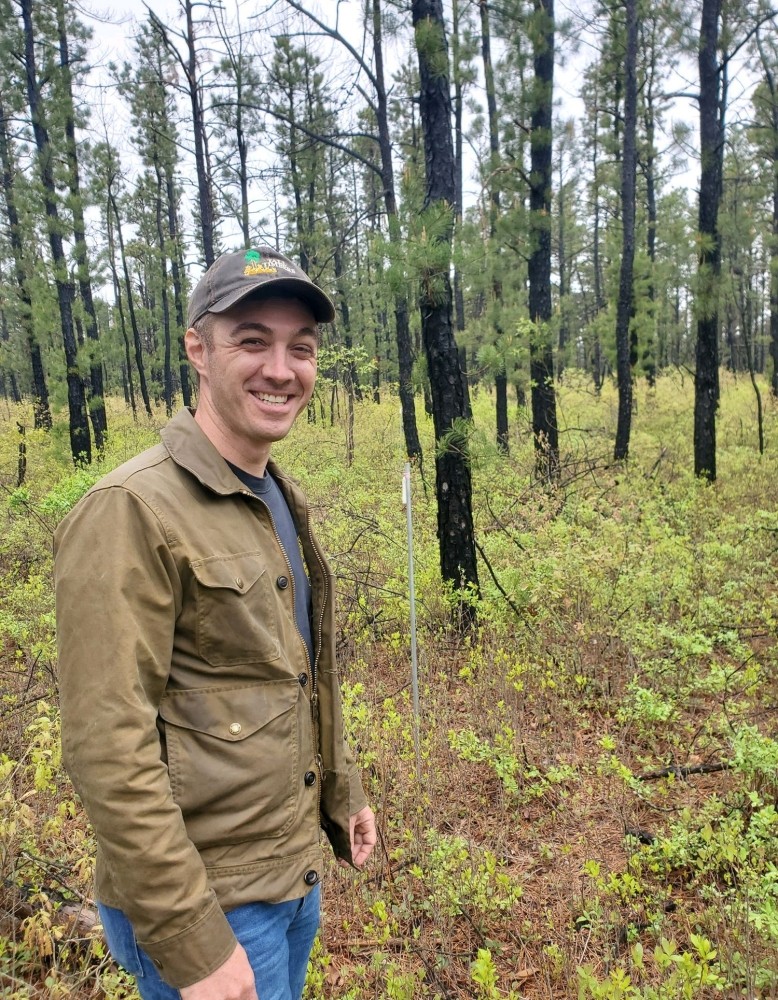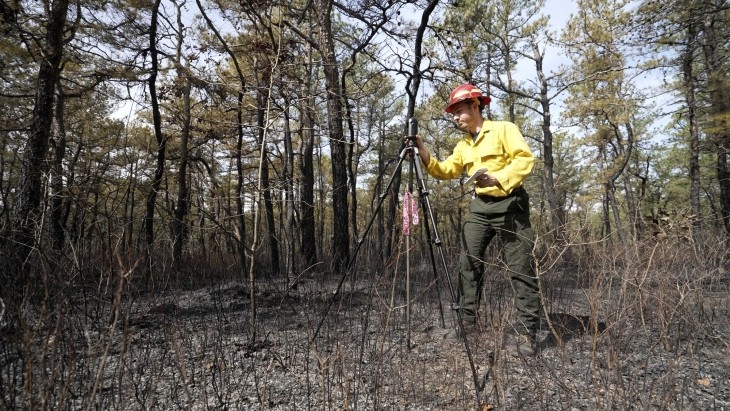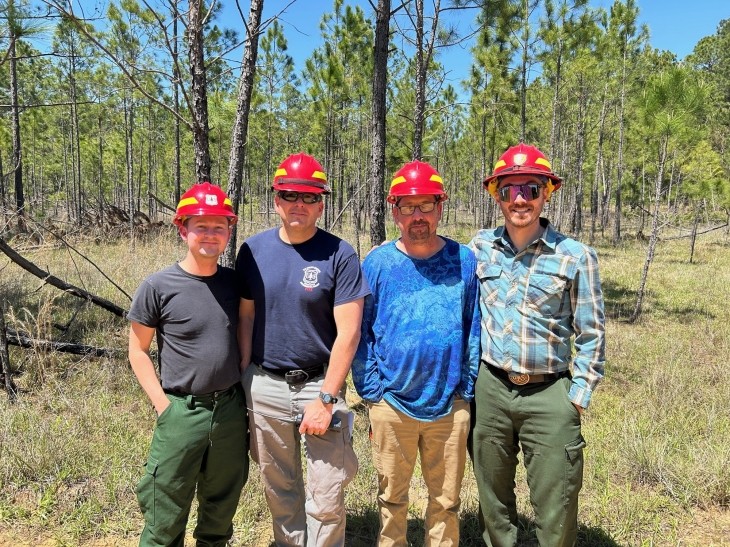
Mike Gallagher is a research ecologist and the lead scientist at the U.S. Forest Service’s Silas Little Experimental Forest in the New Jersey pine barrens. Mike has turned his lifelong interest in fire ecology into a career and now is a leader for the U.S. Forest Service’s Northern Research Station Fire Program. Outside of work, Mike enjoys canoeing and gardening.
I grew up in New Jersey, right on the western edge of the pine barrens. When I was 3, we moved to a new house that was in the pine barrens, and the spongy moth caterpillars were defoliating the backyard. My mom gave me a little pan to go around and collect them. I ended up having buckets of caterpillars. That same year, in 1989, my mom gave me an Audubon field guide to insects and it’s still on my shelf. It was for adults, but it had pictures in it, and I used to try to identify every spider and insect in the backyard from then on. Fire was just something I grew up with living near the pine barrens. Sometimes the school was closed because of wildfires or smoke from it. When I was in first grade I would say I wanted to be a firefighter or a landscaper. I ended up kind of doing both.
I went to Rutgers University and studied ecology and natural resource management. After college, I ended up back in the pine barrens, working on spongy moth defoliation surveys. This was another big defoliation event – 20 years after the outbreak I saw as a kid – and I broke out the same Audubon guide. It was a full circle moment. I took two years off between my bachelor’s and PhD. I worked as a landscaper and at a tree nursery and on a Christmas tree farm. I also got some work on a Forest Service project measuring pitch pines. That position grew into a six-month job, which then became a year, and eventually I got a permanent position.
I’ve been at the Silas Little Experimental Forest since 2008, and I’m now the lead scientist. The property is 592 acres, mostly oak and pine. We have a lot of shortleaf pine here – it’s at its northern extent – and pitch pine. The oaks are a mix of chestnut, white, scarlet, and black. It’s pretty flat here, but if you move down slope, there’s a riparian corridor along a stream, and we have Atlantic white cedar, magnolia, red maple, and sassafras down there. It’s a really neat environment.
After I got the permanent role, I felt like I had enough stability to go back to school at the same time. I got my PhD at Rutgers University in the ecology and evolution program. My research was really focused on wildland fire and methods of evaluating the effects of wildfires and prescribed fires.
I’m a team leader in the Northern Research Station’s fire research work unit. I help steer the program of work for New Jersey and the rest of the region, with regard to fire research. I do a little bit of everything in my work now. I also hire and supervise the employees here at the experimental forest. I write grants and manage them. I build and maintain relationships with land management agencies, mostly state and federal partners such as the New Jersey Forest Fire Service and the U.S. Department of Defense. Another part of it is planning and coordinating technical events, teaching, and training land managers.
I occasionally still do field work, such as collecting LIDAR data. We have terrestrial laser scanners, so we can create a three-dimensional point cloud of our research plots. And I travel to see other sites and programs sometimes. I went to Fort Stewart in Georgia recently. The Department of Defense had a big interagency experiment down there. They have a really impressive prescribed fire program. They burn 115,000 acres a year on this military installation for forest benefit and safety purposes. Because they have a lot of land and burn so much, there’s a lot of opportunity to conduct fireline experiments.
One research project I’m really excited about is studying embers. We are testing these new ember monitoring devices, and some of our partners at the Southern Research Station are using radiometers to measure the energy of the fire and its thermal properties. Not many other people are doing this kind of research; embers are the most understudied part of fire behavior. Embers set a lot of spot fires, set house fires, and contribute to firefighter entrapments. Some of the hot particles contribute to the local fire spread – inside the existing fire – but others land way out in front and make containment difficult. They can create a dangerous situation really quickly. We currently don’t have a good way to predict when or how many embers will occur or where they’re going to go, which makes this research important. We’re learning that fuel reduction through prescribed burning can reduce embers before a fire happens, by consuming pine bark flakes that make up about 75 percent of embers.
Mostly now, instead of collecting the data myself, like I used to, I take it post-processing and convey the results to others. There’s definitely a constant need for education, both managers and the public. In New Jersey we have a lot of turnover – people moving and buying and selling houses. That makes it important to always provide education. We do research on ticks and how prescribed fire can greatly reduce populations for a few years, and the public has a lot of interest in that. So it’s important to communicate those benefits of prescribed fire that people might not know about.
I’d like to update the nation’s fuel models and fire behavior tools with the latest that research has to offer. We’re working on it, but it takes time. We have to turn the concept into a tool that’s easier and faster and requires less of a learning curve. We’d like to be able to take that tool and its outputs to simulate prescribed fires and wildfires quickly to better predict how risk might unfold in a scenario or how preventative work could help mitigate that. We have partners across the country working on different pieces of the problem. Eventually, we’d like to have the capability for managers to be able to scan the land and build a spatially explicit model that shows the fuels and the homes they’re trying to protect and to use that to game the system, and say, “Let’s look at the weather that’s predicted to happen in a couple of years,” or, “Let’s input the weather from the worst fire we’ve ever had,” and see how those scenarios play out. Then they can look at the fuels and see what would happen if they burned or thinned or extended backyards another 30 feet and see how all of that changes the outcomes.
It’s challenging to find enough hours in the day to do everything I want to. There are so many interesting questions and people to work with. The most rewarding part is getting to see or hear about the impacts of our research. When I have a conversation and somebody is talking about embers or the three-dimensional structure of fuels, it makes me feel like our research is getting used and making a difference.
We’re a part of a broader fire research team, and our partners are a really important piece of that. Our staff typically would include a scientist, a station manager, and three technicians. We work with engineers from University of Edinburgh in Scotland and others from Worcester Polytech in Massachusetts and Rochester Institute for Technology in New York. They bring a lot of different skills and tools to the table that we don’t have in our typical forest research toolkit. We also have staff with other skills in Morgantown, West Virginia, and in Lansing, Michigan. The success of our work isn’t just ours, but the success of all the partners who support us. We’re part of a really big interdisciplinary and interagency team. There’s a number of research stations and labs that we collaborate with and learn from. We are all equal partners.





Discussion *